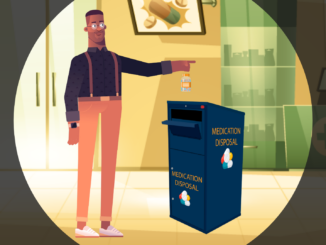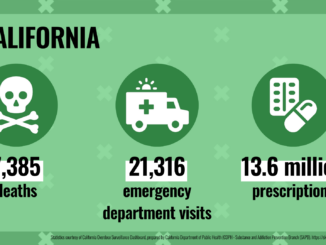
Take-back bins prevent medications from being misused and keeps them from polluting the environment
by Anne Stokes
We talked to Rachel Ross-Donaldson, agency manager for the Tehama County Solid Waste Management Agency, to understand how bins keep communities healthy.
“Use of prescription drugs is very prevalent among Americans, with almost half of the adult population taking at least one prescription drug.”
Rachel Ross-Donaldson, Agency manager, Tehama County Solid Waste Management Agency
How do medication take-back bins benefit the communities they’re in?
Use of prescription drugs is very prevalent among Americans, with almost half of the adult population taking at least one prescription drug, and three-quarters of the senior population taking two or more. According to one study published in Research in Social and Administrative Pharmacy, two out of three prescription drugs were reported to be unused. As a result of the vast amounts of unwanted or expired prescription drugs being so easily accessible, about 20% to 30% of drug abusers in California primarily use prescription drugs.
Additionally, there are environmental concerns regarding prescription drug disposal. According to the EPA (Environmental Protection Agency), half of the water samples from waste water treatment plants contained at least 25 different drugs. This is likely the result of in-home disposal via flushing or solid waste.
Why did Tehama County implement the Med Bin program?
Beginning in 2008 and 2011, stakeholder groups began providing disposal options for home-generated medical sharps and drugs, respectively, through a publicly-funded permanent sharps disposal program and DEA (Drug Enforcement Administration)- funded semiannual temporary drug take-back events. During this time, a total of 2,599 pounds of medicine and an annual average of 2,700 gallons of medical sharps were collected from the local public, showing that there is a growing need for the programs. In order to meet the need for permanent medicine disposal, in 2016 and 2017, permanent drug collection kiosks were placed at the Tehama County Sheriff’s Department and Corning Police Department, respectively.
Have the bins been well-received and used by the community?
Both kiosks are used by the public, with an average of approximately 350 pounds of medicine being collected annually at each site. While this might seem relatively low for a countywide population of just over 65,000 residents, it’s worth noting that collections hosted by law enforcement only collect approximately 7% of the unused drugs in the community.
What types of locations are suitable to host a bin?
Through our continuing sharps disposal program, the Agency has learned that take-back programs that offer convenient collection are the most successful. We’ve seen this data trend throughout the years, whereby our sharps collection kiosks located near doctor offices or pharmacies consistently collect a higher volume of sharps than those sited at unrelated locations, such as HHW (household hazardous waste) facilities or fire departments. Medicine bins follow the same trend.
What types of materials can and cannot be accepted at these bins?
All pharmaceutical drugs can be deposited in our bins. We do not accept illegal substances, needles, or sharps—these items should be brought to a sharps kiosks—or infectious waste.
Is there any assistance available for host sites?
Sites can contact Drug Takeback Solutions Foundation (www.takebackfoundation.org) and MED-Project (med-project.org).
To find a bin near you, go to medtakebackcalifornia.org.
Read more stories about med bins in California’s North Central Valley.
Brought to you by the California Drug Take-Back Program and the California Product Stewardship Council.
Recent facebook posts from California Product Stewardship Council

The California Product Stewardship Council (CPSC) is a powerful network of local governments, non-government organizations, businesses, and individuals supporting policies and projects where producers share in the responsibility for managing problem products at their end of life.
CPSC is California’s thought leader and expert on Product Stewardship and the Extended Producer Responsibility (EPR) movement.
EPR enjoys the support of more than 26 million Californians. That’s nearly 70% of the state's population! Nearly 150 resolutions have been passed by California local jurisdictions and organizations supporting a more sustainable and toxic free environment through product stewardship. CPSC works closely with companies who have redesigned products for reuse as well as those who have established pilot or permanent collection programs with some sharing of costs with others in the product chain.
California Product Stewardship Council


